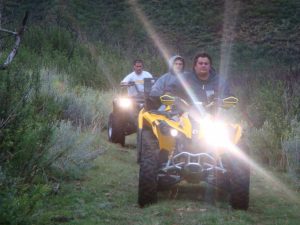At the end of 2008, I had the privilege to join a few friends on a quad bike trip to the Lesotho border. I was assigned to drive the “support vehicle” with all the sleeping material, food and all those beverages that needed to be kept cold…
During our 3 day stay we enjoyed quad biking in one of the most beautiful areas of Southern Africa – and the quad bikes allowed us to explore places where other vehicles would not have been able to cross rivers and streams.
The experience and fun and laughter deserve a blog post on its own – what I would like to focus on in this post is the need for safety! I believe that safety requirements are recognized by quad bikers when riding in competitions and by enthusiasts when preparing to go on pre-planned drives. Safety is however most often neglected at the very informal trips, around the braai and especially when the quad bikers have had a few alcoholic refreshments!
We should be made aware of quad bike safety and reflect on this more often!
I would like to refer to some of the suggestions on the Arrive Alive website:
Planning for Emergency Situations
• Ride with others – never alone!
• Know the location details before they are needed in an emergency.
• Ensure that a designated and responsible person knows the suitable emergency contact procedures.
• Carry a Cellular phone and consider GPS equipment
• Ensure the operators can provide the emergency services with enough detail for them to be found if there is an accident, eg the grid reference, the distance from the main road, the type of access (suitable for car/four-wheel drive/emergency service
• Carry a safety kit that includes flares, a flashlight, compass, blanket, matches and a sounding device.
Route planning – Planning your route will go far towards ensuring the safety of drivers:
• Plan your route to avoid severe slopes and unstable ground conditions.
• Plan regular routes to avoid rocks, stumps, drainage ditches and steep slopes.
• Always survey deep vegetation to identify hidden obstructions.
• Drainage ditches should be piped or bridged on regular routes. Thatch soft spots where necessary.
• Luminous marker posts may be used on permanent routes to help the operator in poor weather or poor light.
• Remove the lower branches of trees on regular routes.
For more information on Quad Bike safety, visit:
- Quad Bikes and Road Safety
- Quad24
